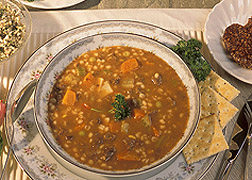| Read the magazine story to find out more. |
|
|
|
|
Strategies to Control Cravings
By Rosalie Marion Bliss
March 30, 2015
An expert in healthy weight-loss interventions funded by the U.S. Department of Agriculture (USDA) is studying complex brain responses to the dramatically changed U.S. food supply. The 2010 Dietary Guidelines for Americans (DGAs) report that during the past four decades, the amount of food on hand to purchase from the U.S. market-in terms of average daily caloric availability—has increased by 600 calories per person.
Susan B. Roberts emphasizes interventions with a high-fiber, slow-digesting carbohydrate intake—at the lower end of the recommended range rather than below it—for weight control because that is a good level where people can enjoy some carbs without having so many that they trigger food cravings and eating-control issues.
Roberts is with the Jean Mayer USDA Human Nutrition Research Center on Aging (HNRCA) at Tufts University in Boston, Massachusetts. The center is funded by the Agricultural Research Service (ARS), which is USDA's chief intramural scientific research agency. Roberts is also professor of both nutrition and psychiatry at Tufts University.
Roberts emphasizes a moderately low carbohydrate intake, rather than a very low carb intake, in keeping with the Recommended Dietary Allowance (RDA) for carbohydrates of 130 grams, or 520 calories, per day. Based on Roberts' studies, another dietary key to managing body weight is getting ample food fiber, which is a subset of the carbohydrate group.
The daily adequate intake for fiber is 38 grams for men and 25 grams for women. But significantly—dietary fiber intake among U.S. consumers averages only 16 grams per day. Fiber is a weight-control cornerstone of Roberts' intervention studies because it helps achieve the feeling of fullness after eating.
Good sources of dietary fiber include legumes (beans and peas), vegetables, fruits, nuts and seeds, and whole grains (unlike refined grains, whole grains contain the entire grain kernel, meaning bran, germ, and endosperm).
Read more about this research in the March 2015 issue of Agricultural Research magazine.

